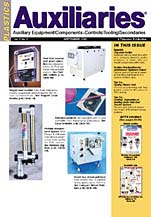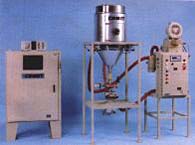







| Drying Nylon | |
| October 1999 issue of Plastics Auxiliaries By Tom Rajkovich, President, Comet Plastic Equipment. |
|
Reprinted with permission from Plastics Auxiliaries Magazine Copyright © 1999 by Tidewater Publications Services, Inc. |
|
 |
Moisture absorption of nylon has been a source of study for many years. While all polymers absorb some amount of moisture, none are as affected as much as nylons.
Nylons are used in a number of applications and offer a combination of strength, stiffness, chemical and impact resistance and good wear and friction characteristics. The American Plastics Council reported that, in 1998, more than 1 billion of nylon were sold in North America and sales are expected to grow, increasing 6 to 10% over the next few years That's a lot of nylon that will require drying. |
| Characteristics of nylon All nylons absorb moisture from their immediate environment and eventually reach a level equal with the relative humidity of the atmosphere. The rate of absorption depends on temperature and humidity. Under atmospheric conditions, virgin nylons absorb moisture slowly, with regrind and larger pellets absorbing faster than smaller pellets. Moisture has a plasticizing effect on nylons that increases flexibility and impact resistance. Over-drying has the opposite effect, causing brittleness. Addition of fillers reduces the effect of moisture by reducing both the volume of nylon polymer in the mixture and the space available to moisture molecules. Glass reinforcements reduce the effects of moisture even more. The moisture absorbed by pellets and regrind must diffuse to the surface before being removed. This diffusion rate is temperature dependent and takes time. The drying time required depends on particle size, dew point and temperature. Signs of wet nylon include: |
|
| Drying Wet Nylon Proper drying of nylon materials requires an awareness and control of the essential variables that affect the drying rate and the ultimate dryness. Nylons must be molded with low moisture content to avoid splay and possible brittleness due to degradation. Some nylons can be used without drying if they are not exposed to humidity (i.e., nylon shipped in closed drums or gaylords). Oven, or dehumidifying dryers are recommended with oven dryer temperatures set at 180 F for 12 hr to sufficiently dry the material. An air oven with recirculated, dehumidified air is recommended. The depth of the resin tray should not exceed 1 in. |
 Some dryers monitor the weight of the material being used AND the temperature of the material. This eliminates over-drying |
Desiccant dryers require a 4-hr residence time. If you are processing 15 lb./hr, you need a 60-lb. drying hopper and a 15 cu-ft/min blower with two or more desiccant towers or rotating desiccant beds. Also, check and record the moisture levels in the nylon on every shift. Do not depend so much on checking the dew point. This is a measure of the relative humidity in the dryer; the lower the dew point, the less residual moisture will be in the pellet for a given drying time. |
|